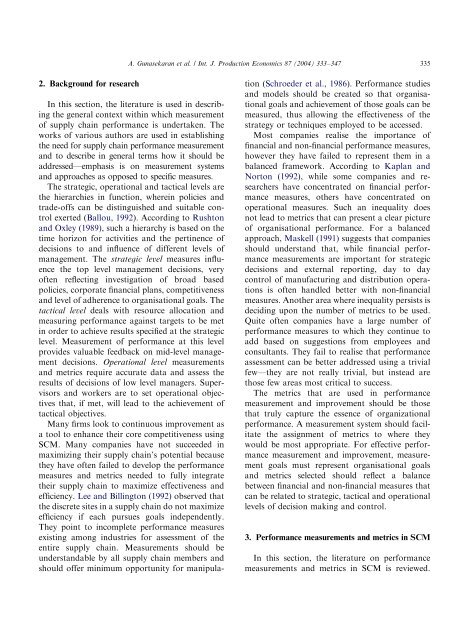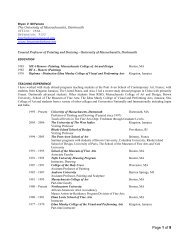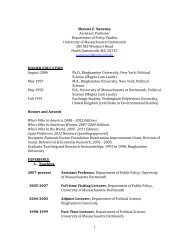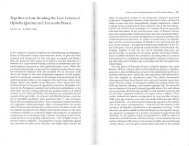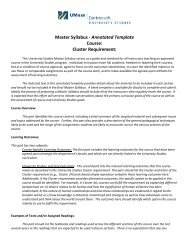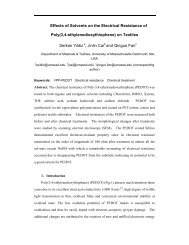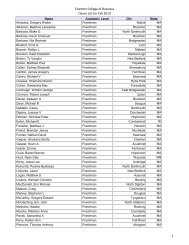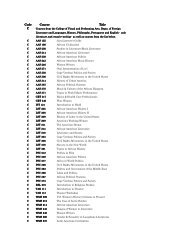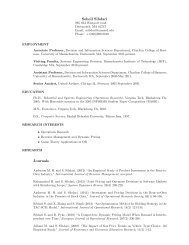A framework for supply chain performance measurement
A framework for supply chain performance measurement
A framework for supply chain performance measurement
Create successful ePaper yourself
Turn your PDF publications into a flip-book with our unique Google optimized e-Paper software.
ARTICLE IN PRESSA. Gunasekaran et al. / Int. J. Production Economics 87 (2004) 333–347 3352. Background <strong>for</strong> researchIn this section, the literature is used in describingthe generalcontext within which <strong>measurement</strong>of <strong>supply</strong> <strong>chain</strong> per<strong>for</strong>mance is undertaken. Theworks of various authors are used in establishingthe need <strong>for</strong> <strong>supply</strong> <strong>chain</strong> per<strong>for</strong>mance <strong>measurement</strong>and to describe in generalterms how it should beaddressed—emphasis is on <strong>measurement</strong> systemsand approaches as opposed to specific measures.The strategic, operational and tactical levels arethe hierarchies in function, wherein policies andtrade-offs can be distinguished and suitable controlexerted(Ballou, 1992). According to Rushtonand Oxley (1989), such a hierarchy is based on thetime horizon <strong>for</strong> activities and the pertinence ofdecisions to and influence of different levels ofmanagement. The strategic level measures influencethe top level management decisions, veryoften reflecting investigation of broad basedpolicies, corporate financial plans, competitivenessand level of adherence to organisational goals. Thetactical level deals with resource allocation andmeasuring per<strong>for</strong>mance against targets to be metin order to achieve results specified at the strategiclevel. Measurement of per<strong>for</strong>mance at this levelprovides valuable feedback on mid-level managementdecisions. Operational level <strong>measurement</strong>sand metrics require accurate data and assess theresults of decisions of low level managers. Supervisorsand workers are to set operationalobjectivesthat, if met, will lead to the achievement oftacticalobjectives.Many firms look to continuous improvement asa toolto enhance their core competitiveness usingSCM. Many companies have not succeeded inmaximizing their <strong>supply</strong> <strong>chain</strong>’s potential becausethey have often failed to develop the per<strong>for</strong>mancemeasures and metrics needed to fully integratetheir <strong>supply</strong> <strong>chain</strong> to maximize effectiveness andefficiency. Lee and Billington (1992) observed thatthe discrete sites in a <strong>supply</strong> <strong>chain</strong> do not maximizeefficiency if each pursues goals independently.They point to incomplete per<strong>for</strong>mance measuresexisting among industries <strong>for</strong> assessment of theentire <strong>supply</strong> <strong>chain</strong>. Measurements should beunderstandable by all <strong>supply</strong> <strong>chain</strong> members andshould offer minimum opportunity <strong>for</strong> manipulation(Schroeder et al., 1986). Per<strong>for</strong>mance studiesand models should be created so that organisationalgoals and achievement of those goals can bemeasured, thus allowing the effectiveness of thestrategy or techniques employed to be accessed.Most companies realise the importance offinancialand non-financialper<strong>for</strong>mance measures,however they have failed to represent them in abalanced <strong>framework</strong>. According to Kaplan andNorton (1992), while some companies and researchershave concentrated on financialper<strong>for</strong>mancemeasures, others have concentrated onoperationalmeasures. Such an inequality doesnot lead to metrics that can present a clear pictureof organisationalper<strong>for</strong>mance. For a balancedapproach, Maskell (1991) suggests that companiesshould understand that, while financial per<strong>for</strong>mance<strong>measurement</strong>s are important <strong>for</strong> strategicdecisions and externalreporting, day to daycontrolof manufacturing and distribution operationsis often handled better with non-financialmeasures. Another area where inequality persists isdeciding upon the number of metrics to be used.Quite often companies have a large number ofper<strong>for</strong>mance measures to which they continue toadd based on suggestions from employees andconsultants. They fail to realise that per<strong>for</strong>manceassessment can be better addressed using a trivialfew—they are not really trivial, but instead arethose few areas most criticalto success.The metrics that are used in per<strong>for</strong>mance<strong>measurement</strong> and improvement should be thosethat truly capture the essence of organizationalper<strong>for</strong>mance. A <strong>measurement</strong> system should facilitatethe assignment of metrics to where theywould be most appropriate. For effective per<strong>for</strong>mance<strong>measurement</strong> and improvement, <strong>measurement</strong>goals must represent organisational goalsand metrics selected should reflect a balancebetween financialand non-financialmeasures thatcan be related to strategic, tactical and operationallevels of decision making and control.3. Per<strong>for</strong>mance <strong>measurement</strong>s and metrics in SCMIn this section, the literature on per<strong>for</strong>mance<strong>measurement</strong>s and metrics in SCM is reviewed.


